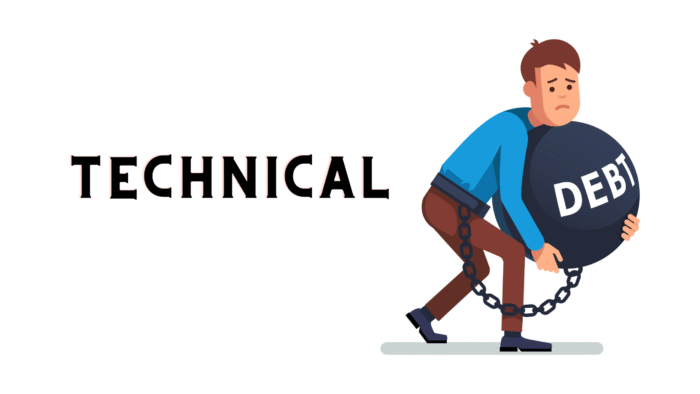Every software development team often encounters a similar challenge. Delivery must be quick, and the code quality must be high.
Even though this is always an objective, it’s not easy to achieve it. This is where technical debt appears, and being able to manage it effectively can make the difference between a thriving codebase and a maintenance nightmare.
What’s technical debt?
In essence, technical debt refers to the future costs incurred by choosing quick solutions over more effective approaches in the development stage. Taking shortcuts to comply with deadlines means borrowing time from the future.
It’s just like a financial debt. You get the benefits immediately, but you will still have to pay interest down the line. The same happens with technical shortcuts. At first, you get short-term gains, but you have to bear in mind the long-term costs, like increased maintenance and slower development.
However, this debt isn’t inherently bad. Sometimes it’s really needed to deliver features quickly to adjust to dynamic market demands and changing priorities.
The problem isn’t with the shortcuts per se, but rather with the fact that many teams don’t count that time in subsequent planning. A technical debt, when left unchecked, gradually compounds and can eventually impact development velocity.
Types of technical debt
It’s also important to understand the different forms of technical debt, as they may require project managers to take different approaches and measures.
- When developers write the code haphazardly just to meet deadlines, it can cause code debt. For example, it can be duplicated logic or unnecessarily complex functions. You’ll feel the consequences when simple adjustments require changes in many files.
- If architecture doesn’t support current needs, it can cause design debt. The original design may perfectly work for smaller applications, but proves insufficient as soon as the systems start to grow.
- When teams disregard writing or updating tech docs, it may result in documentation debt. Later, if someone joins the team, they won’t be able to contribute effectively right away because of the missing documentation.
- Testing debt results from the lack of adequate tests. The codebase in this scenario can be very fragile and suffer from any changes and unexpected functionality.
- When deployment processes or development tools are outdated, it may cause an infrastructure debt. As a result, a team can face slower deployments and reduced productivity.
How does technical debt accumulate?
As we’ve already mentioned, technical debt doesn’t appear out of the blue. It mounts up gradually each day, with every decision and accumulated external pressures. Usually, it’s time pressure that triggers the creation of debt.
When deadlines start to hit one after the other, teams decide to opt for faster solutions rather than better ones. For example, instead of creating solid reusable functions, they may skip testing or just copy-paste code.
When an application starts to grow, design decisions that initially seemed optional and adequate may start showing their limitations. No surprise here, what looks reasonable for smaller systems can easily become insufficient once you have to scale.
Changes within the team also contribute to debt accumulation. Whenever some experienced team member leaves (e.g., developers, QA testers, designers), there emerges a huge knowledge gap.
Managers can hire replacements, but they need time to onboard. Plus, the lack of understanding of existing architecture may lead to inconsistent implementations and decisions.
Finally, the compound effect is what makes debt particularly dangerous. Small shortcuts will create maintenance overhead. That, in its turn, can slow future work and urge the team to implement more shortcuts, trapping them in a vicious circle.
How to incorporate that debt into the workflow?
The first and foremost recommendation for managing technical debt is to treat it as foundational work, not as something you’ll address some time later when you have time.
Try to incorporate debt work in planning while scheduling feature development tasks. The development team has to assign time for addressing debt, just like they allocate it for new features.
Project management tools are indeed essential for tracking and prioritizing debt work. In particular, you need to pay attention to Gantt chart software as it helps to fit your debt work into a general project timeline, and visualize it with dependencies, possible overlaps, and resource requirements.
Gantt charts are extremely helpful in highlighting how debt reduction tasks can go along with feature development. For example, you may see that refactoring a core module has to be done before implementing some dependent features. Gantt chart software will, in general, improve your planning process if used from the very beginning of the project and let you avoid accumulating debts. However, if it’s already there, it can also help you organize work related to technical debt.
Take advantage of a project management system to categorize different debt types. Track development tasks, as well as documentation updates, and infrastructure upgrades separately. Try to address different types of debt work with a balanced approach, focusing on each aspect.
Remember to not treat debt work as filler or side activities. They are as important as primary work and can easily cripple everything if not addressed properly and timely.
Establish debt reduction goals and track progress to see that you’re really dealing with the problem. Keep in mind that some teams allocate around 20% of the overall development time just to deal with debt work.
How to identify and measure technical debt?
You can’t manage something that is not properly measured. Thus, effective debt management first requires identifying the debt and measuring its impact. In that context, code metrics may provide quite objective measurements.
Cyclomatic complexity scores, for example, determine overly complex functions. Code duplication percentages can highlight where you might apply reusable components.
Development velocity metrics unveil how debt affects productivity. Here, you can track how long features take to implement and see when the time is unreasonably increasing. Apart from that, keep track of bug rates and fix times.
Any patterns discovered in code review feedback may reveal debt accumulation. When reviewers consistently raise the same issues or reviews get dragged on, you’re most probably witnessing the debt’s effects.
Another important artefact is developer surveys. They usually provide qualitative data that metrics can’t capture. Find out your team’s pain points, reflect on tasks that take longer than expected, and assess processes in general.
Lastly, try to create a debt inventory. Include all the defined issues with their possible impact and the measures that are required to resolve them. This cna work as a roadmap for debt reduction.
Which prevention strategies can you implement?
As we’ve mentioned above, preventing technical debt may truly cost you less than fixing it afterward. You can implement certain prevention strategies to avoid accumulating unnecessary debt and still deliver features quickly. How to do that?
Set up coding standards and apply them through automated tools. Linters can detect common mistakes before they enter the codebase. These tools reduce mental load, first of all, and help avoid style-related debt.
Then, implement meticulous and structured code review procedures that take account of maintainability in the long term, not just nice functionality. Reviewers must be trained to detect potential debt and adjust processes with better approaches on the go.
To identify architectural debt, implement design reviews for larger features before implementation begins. Involving senior developers in planning may also help identify potential issues with anticipation.
Regular refactoring sessions are helpful for the codebase’s health. Allocate some time in the schedule so that developers can focus on improving code quality rather than adding features. These sessions will help catch issues while they are still insignificant, and not huge problems.
Refactoring and remediation techniques
When prevention strategies don’t work, consider systematic refactoring. It may help reduce existing technical debt without hindering ongoing development. These are some key helpful tips here:
- Find high-impact, low-risk refactoring opportunities.
- Convert duplicated code into reusable functions.
- Make variables more descriptive.
- Break down large functions into smaller ones.
Consider also using the strangler fig pattern for big architectural changes. Gradual replacement of old components with new ones, instead of ambitiously rewriting entire systems, may also help you improve architecture in ongoing feature delivery.
When you can’t immediately fix non-working code, at least try to avoid spreading its complexity to other features. Here, the abstraction layers can help isolate debt-heavy areas from the rest of your system.
Comprehensive tests before major refactoring efforts may become your safety net that prevents improvements from breaking existing functionality. Last but not least, document your refactoring decisions and their rationale. Later on, developers may need to understand the reason behind certain approaches and how they helped.
Tools and automation
It’s important to choose the right tools, as they will add a systematic approach to technical debt management. Let’s see which tools these are.
To begin with, static analysis tools will excel in the automatic identification of code quality issues, security vulnerabilities, and architectural problems. You may try SonarQube, which ensures objective measurements of code quality and also monitors improvements over time.
Automated testing frameworks can catch regressions during refactoring. CI systems run these tests automatically, so any improvements are secured. Dependency management tools assist with tracking outdated libraries and security vulnerabilities. Here, you can test Dependabot. It automatically creates pull requests and updates dependencies.
To reduce documentation debt, refer to documentation generation tools that can create API docs automatically based on code comments. For example, it can be Swagger. This tool helps keep documentation synchronized with code changes.
Finally, implement performance monitoring tools to determine technical debt’s impact on application performance. The reason is simple: when debt starts slowing down your application, these tools will provide metrics to justify debt reduction work.
How to maintain technical debt in the long term?
Technical debt management isn’t a one-time activity that you’ll implement once and forget about. It’s an ongoing process that has to become a part of development.
Track progress towards debt reduction goals regularly. Dashboards with debt metrics shown together with feature delivery metrics have proved to be very effective, as they help teams balance delivery pressure with code quality.
People play a very important role in technical debt. Train each new team member on how you identify debt and prevent it. Code quality should be a part of their onboarding process. When everyone understands the consequences of debt management, it becomes a shared responsibility.
Note that regular architecture reviews can also help identify emerging debt before it becomes a critical problem without a solution. Therefore, scheduling quarterly sessions to evaluate whether the existing architecture is still relevant, may be quite effective.
And once again, don’t treat debt reduction as something that should be dealt with during slack time. Allocate proper time, people, and resources to debt management activities. Feedback loops can help you learn from past tasks and projects. Thus, whenever you discover significant debt, analyze how it developed and what could have prevented it.
Key takeaway
Technical debt is often an integral part of software development, and it must be managed accordingly. Understanding how it accumulates and which practices to implement to address it will help you deliver projects with better results, less stress, and higher quality.
There’s nothing difficult about it. Make debt visible, plan for its management, and create a culture where code quality matters as much as feature delivery. As a matter of fact, teams that manage to find this balance deliver features faster with fewer bugs and prove that investing in debt management truly pays off.



